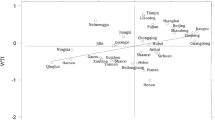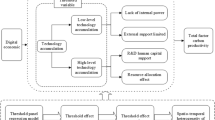Abstract
Under the background of low-carbon economy, carbon productivity is a core criterion of the quality of economy growth. Based on panel data released from 1998 to 2012, carbon productivity in industrial sector is measured by the data envelopment analysis method based on directional distance function, under total factor productivity framework. For technological progress is an important impetus of productivity improvements, we do an analysis of technological progress route alternative issue about carbon productivity promotion in China’s industrial sector. Our main findings are as follows. Firstly, the carbon productivity, which is estimated under the research framework of total factor productivity, is significantly lower than the single element carbon productivity. Secondly, the major representation of technological progress in China’s industrial sector lies in capitalized embodied progress. Finally, capitalized embodied technological progress has a tremendous impact on carbon productivity. Looking ahead, the Chinese government should adopt measures to increase the amount of imported advanced equipment and improve domestic manufacturing level of equipment.

Similar content being viewed by others
References
Beinhocker E, Oppenheim J, Irons B, Lahti M, Farrell D, Nyquist S, Remes J, Nauclér T, Enkvist P (2008) The carbon productivity challenge: Curbing climate change and sustaining economic growth. McKinsey Global Institute, McKinsey Climate Change Special Initiative. Retrived from http://www.mckinsey.com/insights/energy_resources_materials/the_carbon_productivity_challenge
Benhabib J, Spiegel MM (1994) The role of human capital in economic development: evidence from aggregate cross-country data. J Monet Econ 34(2):143–173
Benhabib J, Spiegel MM (2005) Human capital and technology diffusion. In: Aghion P, Durlauf S (eds) Handbook of economic growth, 4th edn, vol 1, part A. Amsterdam, North Holland, p 935–966
Datta A, Mohtadi H (2006) Endogenous imitation and technology absorption in a model of North–South trade. Int Econ J 20:431–459
Denison EF (1962) The sources of economic growth in the United States and the alternatives before us. Committee for Economic Development, New York
Dong Z, Wang L (2011) The cycle fluctuation relationship of capital embodied technical change and economic growth. Seek Truth 38:63–68
Färe R, Grosskopf S, Weber WL (2004) The effect of risk-based capital requirements on profit efficiency in banking. Appl Econ 36:1731–1743
Fuhua Y (2010) The potential economic growth of china with restraint of low carbon economy. Econ Res J 8:79–89
Grossman GA, Helpman E (1991) Innovation and growth in the global economy. MIT Press, Cambridge
He J, Su M (2009) Carbon productivity analysis to address global climate change. China Soft Sci 10:42–47
Huang X, Liu Y (2006) Embodied technical change and Chinese industry’s productivity growth. J Quant Tech Econ 4:52–60
Keller W (2001) International technology diffusion. NBER Working Papers
Kendrick JW (1961) Productivity trends in the United State. Princeton University Press, Princeton
Kuosmanen T (2005) Weak disposability in nonparametric production analysis with undesirable outputs. Am J Agric Econ 87(4):1077–1082
Lin Y, Ren R (2007) East Asian miracle debate revisited. Econ Res J 8:4–11
Liu G-P, CAO L-P (2011) Research on carbon productivity based on welfare performance. Soft Sci 25(1):71–74
Pan J, Zhang L-F (2011) Research on the regional variation of carbon productivity in China. China Ind Econ 5:47–57
Price L, Worrell E, Martin N et al (2000) China’s industrial sector in an international context. Lawrence Berkeley National Laboratory, Berkeley
Romer PM (1990) Endogenous technological change. J Polit Econ 98(5):71–102
Shi C, Lei Z (2009) Business cycle and technical changes of China. J Quant Tech Econ 4:19–32
Wang X, Zhang Y (2010) The empirical estimation of chinese technological change level. China Soft Sci 4:155–163
Wei M, Cao M, Jiang J (2010) Determinants of long-run carbon emission performance. J Quant Tech Econ 9:43–52
Won-kyu, K (2010) Current issues and implications of Korea’s carbon productivity. http://kiet.re.kr/UpFile/newsbrief/1266304157908.pdf,Jan,2010
Yi G, Fan G, Li Y (2003) A theoretical analysis on economic growth in China and total factor productivity. Econ Res J 8:13–20
Yokobori K, Kaya Y (1999) Environment, energy and economy: strategies for sustainability. Bookwell Publications, Delhi
Zhan W, Zhu D, Bai Z (2010) Research on relationship between industrial carbon emissions and carbon productivity in Shanghai. J. China Popul Res Environ 20:24–29
Zhang Z, Ye J (2015) Decomposition of environmental total factor productivity growth using hyperbolic distance functions: a panel data analysis for China. Energy Econ 47:87–97
Zhao Z, Lǜ B, Guo Q , Jia J (2007) On the dynamic integration of capital accumulation and technological progress: a stylized fact in China's economic growth. Econ Res J 11:18–31
Acknowledgments
This work was financially supported by Humanity and Social Science Youth foundation from Ministry of Education of China (No. 15YJCZH046), Youth Research Fund from Shanxi University of Finance and Economics (QN-2014002)
Author information
Authors and Affiliations
Corresponding author
Rights and permissions
About this article
Cite this article
Gao, W., Zhu, Z. The technological progress route alternative of carbon productivity promotion in China’s industrial sector. Nat Hazards 82, 1803–1815 (2016). https://doi.org/10.1007/s11069-016-2271-7
Received:
Accepted:
Published:
Issue Date:
DOI: https://doi.org/10.1007/s11069-016-2271-7




